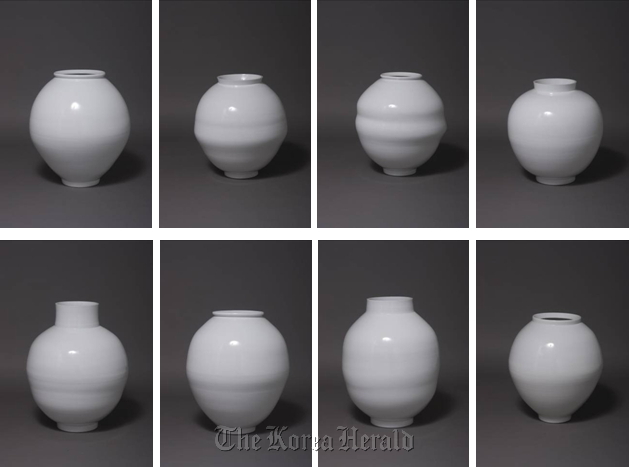‘The Moon Project’: Korean porcelain reinterpreted
By Lee Woo-youngPublished : July 8, 2012 - 18:05
Modernized white porcelain works appeal to international viewers at the 18th Biennale of Sydney
Two female Korean artists are showcasing collaborative works at the 18th Biennale of Sydney, revealing the beauty of Korean white porcelain reinterpreted in a modern way for international audiences.
Ceramic artist Park Young-sook and sculptor Yee Soo-kyung have collaborated in “The Moon Project,” in which Park shows her signature white porcelain pieces “Moon Jars” and Yee presents a ball-shaped sculpture with ceramic pieces of Park’s broken “Moon Jars” pieced together on the exterior.
Two female Korean artists are showcasing collaborative works at the 18th Biennale of Sydney, revealing the beauty of Korean white porcelain reinterpreted in a modern way for international audiences.
Ceramic artist Park Young-sook and sculptor Yee Soo-kyung have collaborated in “The Moon Project,” in which Park shows her signature white porcelain pieces “Moon Jars” and Yee presents a ball-shaped sculpture with ceramic pieces of Park’s broken “Moon Jars” pieced together on the exterior.

Under the biennale theme of “All Our Relations,” the two artists present the two different art genres using the same materials in order to emphasize the meaning of relationship as well as to introduce the essence of Korean beauty to international viewers.
“We are glad that we can introduce the beautiful Korean white porcelain to the world and thankful to the biennale for giving us the chance. We are presenting the simple yet elegant white porcelain pieces, which resemble the minds of Korean people, to international viewers through 12 pieces of ‘Moon Jars’ and ‘Translated Vase ― The Moon,’” Park said at a press meeting at Gallery Hyundai in Seoul last month.
Started in 1973, the third-oldest biennale after Venice and Sao Paolo has invited more than 100 artists across the world to showcase their works from June 27 to Sept. 16 at five locations, including the newly renovated Museum of Contemporary Art Australia, where the Korean artists’ works are on display.
Korean artists were invited to the second biennale in 1976 and to the 17th in 2010.
Park’s 12 white porcelains is part of her “Moon Jar” series, reflecting the inherited beauty and spirit of white porcelains of Joseon Dynasty and new level of beauty and strength. The use of white porcelains dates back to Joseon Dynasty (1392-1910) when they were made to reflect Korean Confucianism, characterized with understated decoration and subtle use of color.
Park’s series is the culmination of 10 years of dedication as the process of making the works is complicated.
As the upper part of a “Moon Jar” is bigger than the lower half and the rim is often wider than the base, it is easy to break. Only one out of ten Moon Jars finally survives in the kiln.
“My ‘Moon Jar’ project shares a common philosophy with the biennale’s theme because they become a single whole when the upper part and lower part adhere well at a high temperature,” said Park. “This is similar to our everyday lives in which we continue to understand each other and make relationships.”
Park freed herself from the guilt she felt whenever she had to discard the failed pieces of Moon Jars with Yee’s collaborative work featuring fragments of her failed pieces.
She is said to pray before she discards the fragments as she believes her works are all made with parts from nature ― soil, air, fire and water.
And Yee’s “Translated Vase ― The Moon” breathes new life into old ceramic fragments of Park.
“Through the hands of Yee Soo-kyung the shattered and unaccepted pieces are born again as new pieces of art,” Park said.
Yee said she tried to focus on the circle of life by putting the pieces together and covering the seams with 24-karat gold.
“I am really interested in things that are broken, and have failed. Because I believe that it is the turning point of art to reborn. A broken ceramic piece finds another piece and they rely on each other. The crack, which symbolizes the wound, is emphasized with the gild,” Yee explained.
“This work is a metaphor of a struggle for life that makes people become more mature and beautiful as they overcome sufferings,“ Yee said.
By Lee Woo-young (wylee@heraldcorp.com)





![[KH Explains] No more 'Michael' at Kakao Games](http://res.heraldm.com/phpwas/restmb_idxmake.php?idx=644&simg=/content/image/2024/04/28/20240428050183_0.jpg&u=20240428180321)












![[Herald Interview] Mistakes turn into blessings in street performance, director says](http://res.heraldm.com/phpwas/restmb_idxmake.php?idx=652&simg=/content/image/2024/04/28/20240428050150_0.jpg&u=20240428174656)
